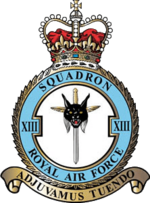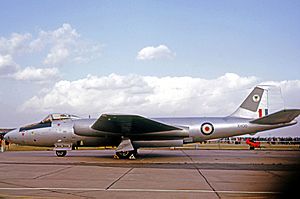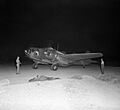No. 13 Squadron RAF facts for kids
Quick facts for kids No. XIII Squadron RAF |
|
|---|---|

Squadron badge
|
|
| Active | 10 January 1915 – 1 April 1918 (RFC) 1 April 1918 – 31 December 1919 (RAF) 1 April 1924 – 19 April 1946 1 September 1946 – 1 January 1982 1 January 1990 – 13 May 2011 26 October 2012 – present |
| Country | |
| Branch | |
| Type | Remotely Piloted Air System squadron |
| Role | Intelligence, surveillance, target acquisition, and reconnaissance (ISTAR) and attack |
| Part of | No. 1 Group |
| Home station | RAF Waddington |
| Nickname(s) | 'The Stabbed Cats' |
| Motto(s) | Adjuvamus tuendo (Latin for 'We assist by watching') |
| Aircraft | General Atomics MQ-9A Reaper |
| Battle honours |
|
| Insignia | |
| Squadron code | AN (1939) OO (1939-1942) |
| Squadron badge heraldry | In front of a dagger, a lynx's head affrontee. |
| Squadron markings |  |
No. 13 Squadron, also known as XIII Squadron, is a special unit of the Royal Air Force (RAF). They fly advanced aircraft called General Atomics MQ-9A Reaper Reaper drones. These drones are controlled remotely, meaning pilots fly them from the ground. The squadron is based at RAF Waddington.
No. 13 Squadron first started on January 10, 1915, as part of the Royal Flying Corps. Over the years, they have flown many different types of aircraft. These include planes like the Martinsyde G.100 and Sopwith Dolphin in World War I. In World War II, they used planes like the Westland Lysander and Bristol Blenheim. Later, they flew jet aircraft such as the Gloster Meteor and English Electric Canberra for taking photos from the sky. From 1990 to 2011, they operated the Panavia Tornado jet. Today, they continue their important work with the Reaper drones.
Contents
Squadron History
World War I Missions
No. XIII Squadron of the Royal Flying Corps began on January 10, 1915. It was formed in Hampshire, England. By October 1915, the squadron moved to France to join the Western Front.
At first, their job was to help the Army by observing enemy movements. They also started doing bombing raids. They were pioneers in "formation bombing," where multiple planes flew together to drop bombs. During this war, they flew various aircraft. These included the Martinsyde G.100, Royal Aircraft Factory F.E.2, and Sopwith Dolphin fighters. The squadron was temporarily closed down on December 31, 1919.
World War II Operations
The squadron was restarted on April 1, 1924, at RAF Kenley. Before World War II, they operated from different bases in the UK. They used planes like the Bristol F.2 and Hawker Hector to help the army.
By January 1939, they were flying Westland Lysander aircraft. They moved to France in October 1939. However, they had to return to the UK in May 1940 after the Fall of France. In May 1941, No. XIII Squadron changed its role. They began flying different bomber aircraft, like the Bristol Blenheim and Douglas Boston. They flew these planes in the Mediterranean region until the war ended. The squadron was then closed again on April 19, 1946.
Cold War Reconnaissance (1946–1982)

No. XIII Squadron was reformed on September 1, 1946. It became No. 13 (Photographic Reconnaissance) Squadron. This means their main job was to take photos from the air. They started flying the de Havilland Mosquito PR.34.
The squadron moved to Egypt. In 1952, they switched to the Gloster Meteor PR.10. By 1956, they were flying the English Electric Canberra PR.7. During the 1956 Suez Crisis, the squadron flew reconnaissance flights over Syria. One of their Canberra planes was shot down by the Syrian Air Force.
In 1978, the squadron moved to RAF Wyton in the UK. They continued flying Canberra PR.7 and PR.9s. The squadron was closed down again on January 1, 1982.
Gulf War Missions
The squadron was reformed on January 1, 1990, at RAF Honington. They were equipped with Panavia Tornado GR.1A aircraft. These planes had new reconnaissance equipment. This equipment used infra-red sensors and video recorders. It allowed the crew to see images in real-time, even at night or in bad weather.
In late 1990, forces were sent to the Gulf. The Tornado GR.1A's night reconnaissance skills were very important. On January 15/16, 1991, six aircraft were sent to Saudi Arabia. During the first nights of the war, they found several hidden Scud sites. Most missions were to find Iraqi ground forces in Central and Eastern Iraq. This helped prepare for the ground attack.
The GR.1As flew at night and at low levels throughout the conflict. The squadron also helped develop the Tornado/TIALD system. This system used thermal imaging and laser targeting. After the war, the squadron continued training at RAF Honington. They also helped monitor a No-Fly Zone in Southern Iraq.
Operations from RAF Marham
On February 1, 1994, No. XIII Squadron moved to RAF Marham. From there, they took part in many exercises around the world. They also continued to deploy for real operations. They monitored No-Fly Zones in Iraq during Operation Warden and Operation Bolton.
In early 2003, XIII Squadron crews joined the Ali Al Salem Combat Air Wing. They flew missions to hunt for Scud missiles in Iraq during the 2003 Iraq War. The squadron also flew the last Tornado mission for Operation Telic in 2009.
In 2010, the squadron provided air support in Afghanistan during Operation Herrick. In 2011, they fired Storm Shadow missiles at Libya. This was during the early days of Operation Ellamy. A few weeks later, on May 13, 2011, the squadron was closed down. This was part of a plan to reduce military forces.
MQ-9 Reaper Drones (2012–Present)
When XIII (Tornado) Squadron was closed in May 2011, the Chief of the Air Staff announced something new. A second unit would be formed to operate the MQ-9 Reaper RPAS (Remotely Piloted Air System). This new unit would be given the No. XIII Squadron name.
XIII (Reaper) Squadron was reformed on October 26, 2012, at RAF Waddington. Soon after, in April 2013, the squadron flew its first remote operational mission from the UK. A few days later, they carried out their first remote weapons strike. The squadron plans to upgrade to the new Protector RG Mk1 drone around 2024.
Aircraft Operated
Here is a list of aircraft that No. 13 Squadron has flown:
- Royal Aircraft Factory B.E.2 c, d, and e variants (1915 – 1917)
- Royal Aircraft Factory R.E.8 (1917 – 1919)
- Bristol F.2B Fighter (1924 – 1928)
- Armstrong Whitworth Atlas (1927 – 1932)
- Hawker Audax (1932 – 1937)
- Hawker Hector (1937 – 1939)
- Westland Lysander Mk I, Mk II, Mk III (1939 – 1941)
- Bristol Blenheim Mk IV, Mk V (1941 – 1943)
- Lockheed Ventura (1943 – 1943)
- Martin Baltimore B.IV, B.V (1944 – 1944)
- Douglas Boston Mk IV, Mk V (1944 – 1946)
- de Havilland Mosquito PR.34 (1946 – 1952)
- Gloster Meteor Meteor PR.10 (1952 – 1956)
- English Electric Canberra PR.7, PR.9 (1956 – 1982)
- Panavia Tornado GR1A, GR4A (1990 – 2011)
- General Atomics MQ-9A Reaper (2012 – present)
Images for kids
-
A Lysander from No. 13 Squadron helps the Home Guard practice aiming in September 1940.
-
Workers from No. 13 Squadron get a Bristol Blenheim Mark VD ready for a mission in Algeria during World War II.
-
A Panavia Tornado GR1A from No. 13 Squadron at RAF Brize Norton in September 1991.
-
An RAF General Atomics MQ-9A Reaper drone at Kandahar Airfield in Afghanistan.
See also
- List of RAF squadrons








